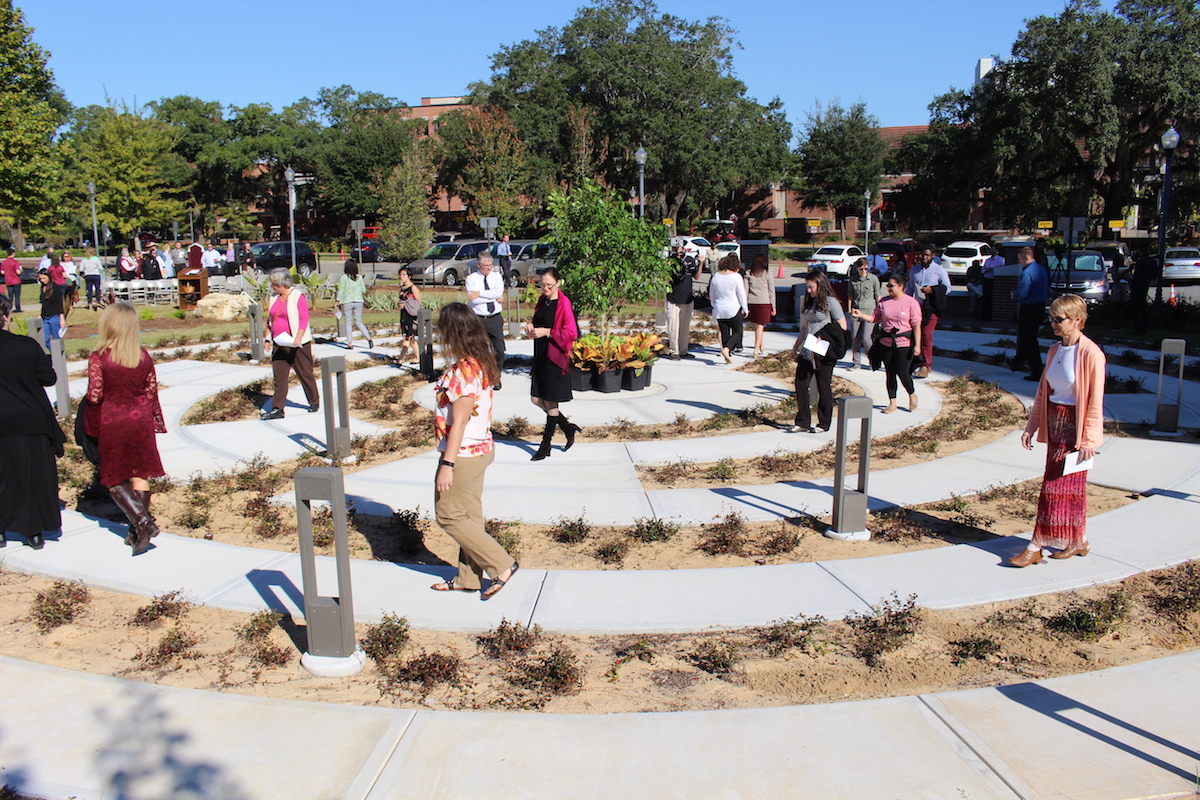Spiritual Life Project unveils new labyrinth
Sometimes all it takes is one question.
Dozens of members of the Florida State University community on Thursday took an inaugural walk along a new path — a labyrinth that winds through a new garden in the space between the Psychology building and the College of Medicine — because a student asked “why not?”
The celebration is the culmination of more than two years of work to plan a campus space dedicated to reflection, a process that started in 2014 when then-student Hunter Anger’s question sparked the inspiration that has been carried forward by his instructors, Erica Wiborg and Dr. Jillian White. With partnerships across campus and beyond, the plans for the project coalesced into the new Florida State University Labyrinth.

newest space on campus devoted to reflection and well-being on Nov. 2, 2017.
A labyrinth is not a maze, Dr. Laura Osteen, the director of the Center for Leadership & Social Change and a member of the labyrinth planning committee, emphasized to those gathered to celebrate the project.
While a maze is a puzzle to be solved, a labyrinth is a winding path that moves in turns toward the center, where there is a space for reflection. Travelers of the labyrinth return along the same path.
“A labyrinth is the opposite of a maze. It is not designed for you to get lost in your walk, but instead to get lost and found in your thoughts,” she said.
The labyrinth sends a message that health and wellness is a priority for the university, said Amy Hecht, vice president for the Division of Student Affairs.
Spaces such as the labyrinth, Hecht said, emphasize to students “that not only what happens in the classroom and academics matter as they develop into the people they will become, but their mind and their body matter as well as they seek to develop and stretch themselves.”
White told the audience that as the “speed with which we move and communicate increases, it can be challenging to justify time to slow down and think; however those times of intentional thought and reflection enhance our capacity for future action.”
Osteen called the labyrinth a gift of time.
“To walk a labyrinth is to slow down, to give yourself time to focus on what’s weighing on, racing around, or possibly hiding in your mind and heart,” she said. “A labyrinth allows us to pay attention to our thoughts, and I propose that attention, our ability to awaken to ourselves and each other, that attention is exactly what sparks, sustains and informs all change.”
One of the primary goals in planning the labyrinth was a focus on accessibility. The walkways incorporate wide paths and turning areas that will accommodate wheelchairs. The entrance to the walking path also includes a tactile labyrinth carved into granite, provided by the Master Craftsman Studio, that allows visitors to trace the same path of the labyrinth with their hands.
White said that a spirit of collaboration infuses the labyrinth and its surrounding features.
Support from across campus was critical in materially answering one student’s “why not?” in regard to creating this space— including administration, facilities, the Spiritual Life Project, and campus colleges and departments. But that collaborative spirit goes beyond the creation of the space.
“While we often think of reflection as a solitary endeavor, our reflections can be more powerful when they are shared, when we make time to listen and respond,” White said. “This labyrinth came to be not because people were assigned to tasks or work, but because of a shared vision. I believe the FSU Labyrinth is a space where we can grow as individuals and in community.”


